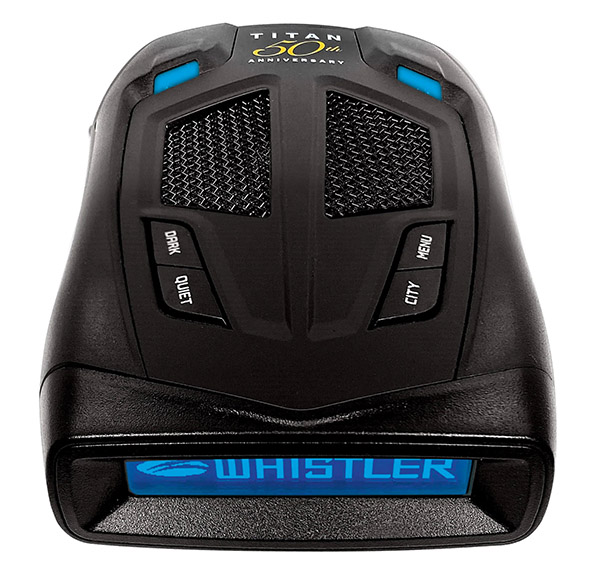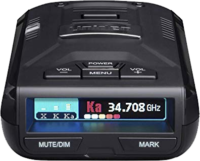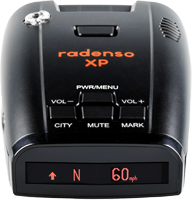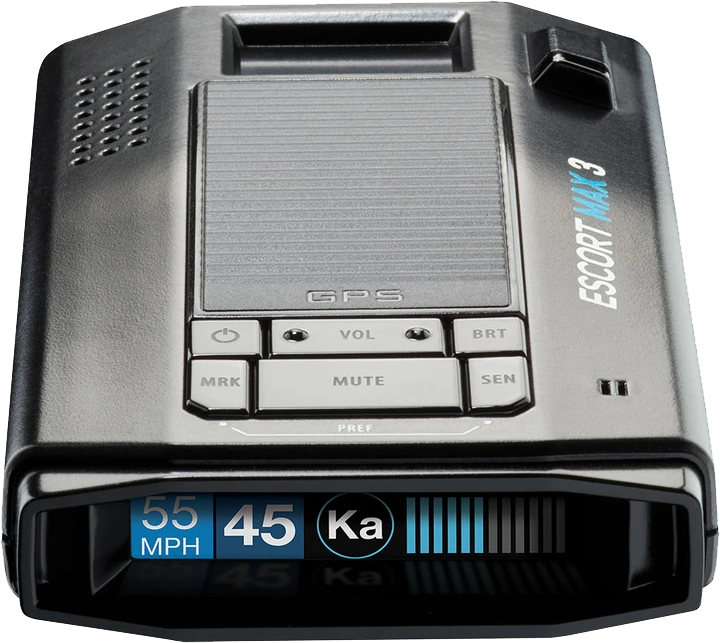Whistler has just released the new Titan ($349). This is the first Whistler radar detector that can truly compete with the big dogs. Thanks to its all new DSP platform, it offers improved signal analysis giving us both longer range and fewer false alerts. The Titan is a long range detector like the Uniden R3, plus it introduces several brand new features which are a first for Whistler including GPS lockouts, a 3 digit frequency display, customizable preset modes, and MRCD/CT detection.
This is a big step up from the CR97 in terms of both performance and false alert filtering, plus it fixes some of the annoyances like the K/Ka confusion. The Titan finally puts Whistler in the big leagues if you’re looking for a high performance and nicely featured radar detector.
You can order the Whistler Titan here.
Full disclosure: I’ve been beta testing the Titan off and on for a year, since August 2021. It was sent to me for free by Whistler for test and review purposes. I’ve tested both beta and production firmware. My pre-production test detector is running production hardware.
In addition to this full written review, you can also check out my complete video review here:
Whistler Titan Overview
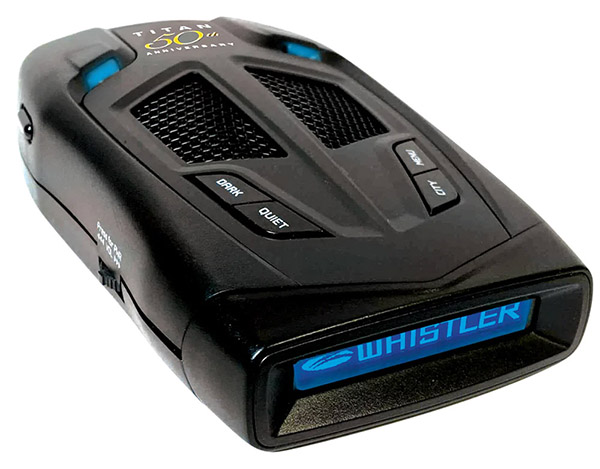
Here are some of the Titan’s key features:
- All new DSP platform
- Long range radar detection
- Good BSM filtering
- MRCD / MRCT photo radar detection
- Manual and Automatic GPS lockouts
- Manually adjustable sensitivity for X/K/Ka
- Multiple speed-based muting options
- Red light camera & speed camera GPS database
- Ka band segmentation
- Firmware updatable via USB (PC only, no Mac)
- Blue OLED display
- Display can autodim based on GPS time (no ambient light sensor)
- Laser signature ID to display laser signal pulse rate
- Lock out laser falses by pulse rate
- Segmentation of laser signals based on pulse rate
- 3 programmable user modes to quickly switch between settings presets
Long Range Detection
So how does the Titan stack up to the competition? Well last year I did a huge shootout with a ton of detectors in the forest picking up 34.7 around a bend.
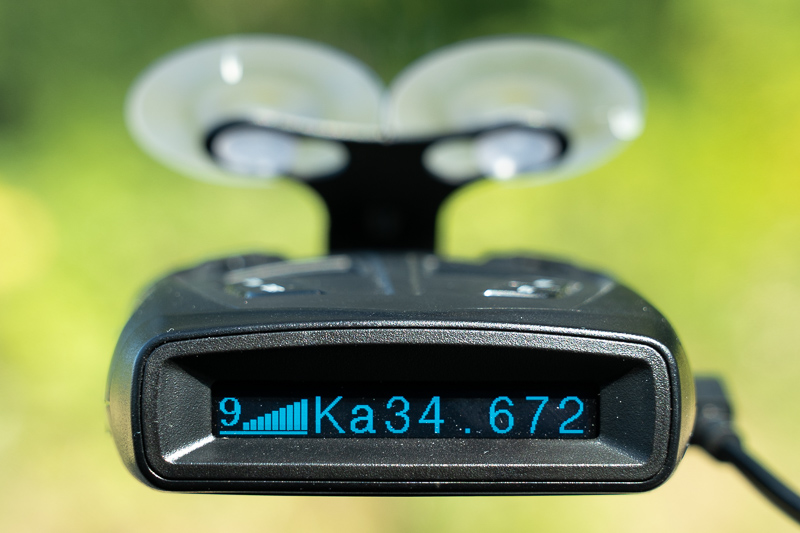
This was with beta firmware (which I’ll talk about more in just a moment), but as you can see the new Titan performs right up there with comparable detectors like the Uniden R3 and Escort Max 3, despite the lack of an LNA, and it’s a big step up over the CR97.
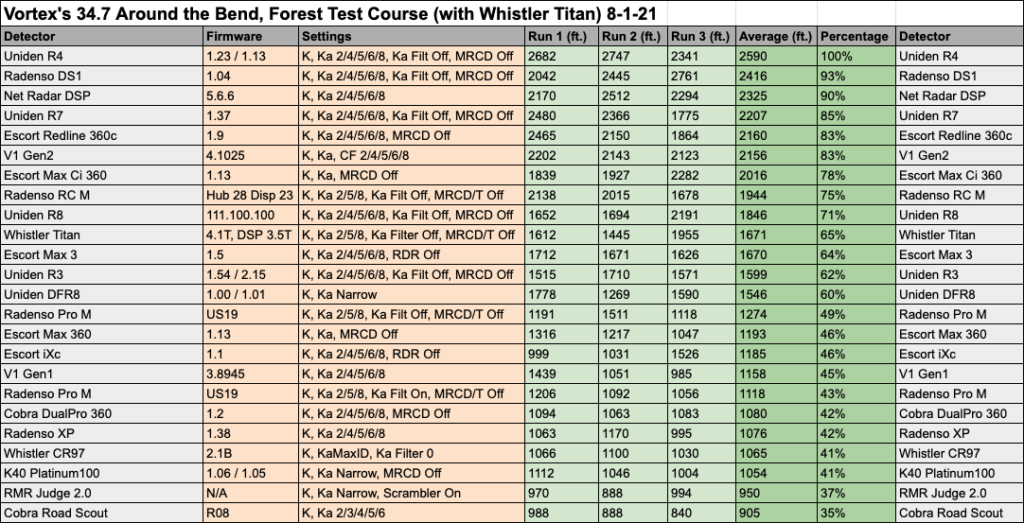

I also did some testing on my standard red barn course. Again it was pretty close to the R3 and Max 3. First up, here’s the 33.8 results.

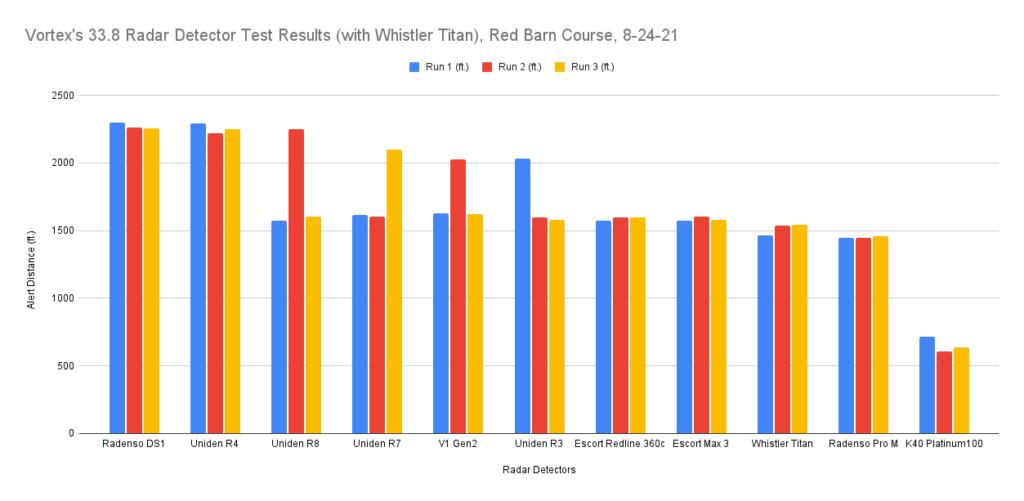
Things were pretty terrain limited with lots of detectors alerting right around the same spot as you can see. Sometimes a some detectors managed slightly longer detections, but not always.
Next up here’s 34.7 where I saw a bit more variance.

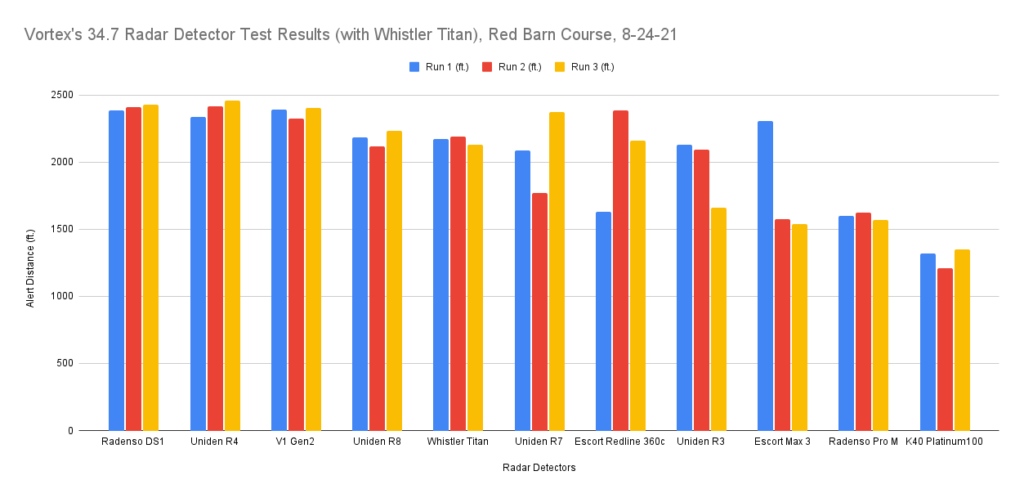
Here the Titan managed to again just edge out the R3 and Max 3, like on the other test course. Awesome stuff.
Then moving onto 35.5, things were a bit tougher.

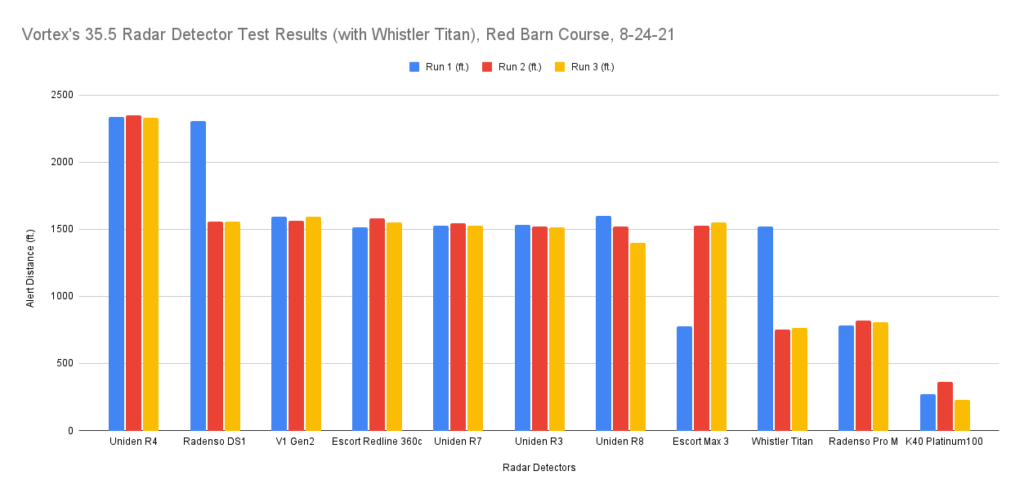 Again things were pretty terrain limited. The R3 managed longer detections all three times, the Max 3 twice, and the Titan once.
Again things were pretty terrain limited. The R3 managed longer detections all three times, the Max 3 twice, and the Titan once.
After this testing, Whistler made some tweaks to Ka band to try and minimize the chances of missing those weak signals and hopefully improving the odds you’d pick up those long distance whiffs of radar. That said, it shouldn’t positively or negatively sensitivity. Regardless, it’s possible that current firmware may perform a smidge better, but I haven’t yet retested after they made these changes.
As an added note, many other detectors have been updated since too. Some detectors like the V1 Gen2 have received updates that have improved their range. So these two tests aren’t designed to be the end all be all. They never are. These are just some early data points. I also have only tested Ka band so far, not X or K band.
My main takeaways are:
- The new Whistler Titan performs much better than Whistler’s previous flagship, the CR97.
- The Titan is able to trade shots back and forth with other comparable long range detectors.
BSM Filtering
When it comes to BSM filtering, the Titan seems pretty comparable to other detectors. It’s pretty quiet overall, though I do see some falses to Hondas, Acuras, Mazda CX-5’s, Chryslers, and Buicks. On a 6 hour drive, I may see only 4-5 BSM falses which is pretty impressive.
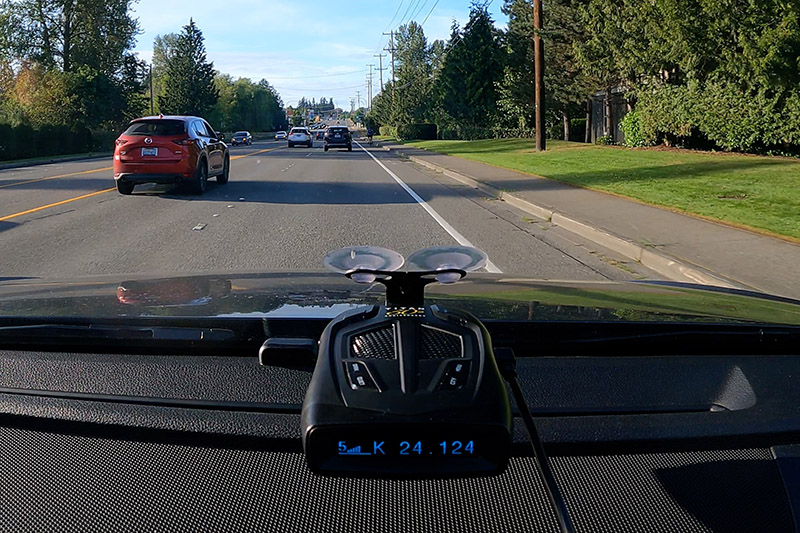
For additional filtering I’d like to see The Titan offer some 24.124’ish, 24.167’ish, and 24.199’ish K Block/Notch style muting options like we have with other detectors in order to to help knock out weak BSM falses, but even without that capability, the Titan still keeps BSM falses pretty well controlled.
GPS Lockouts
The Titan now adds both manual and automatic GPS lockouts, a first for Whistler. This is awesome for filtering out false alerts from stationary speed signs around town, for example. The lockouts do behave slightly differently than other detectors so here’s how they work here:
To manually lock out a stationary false, double press the “Quiet” button on top of the detector, ideally when the signal strength hits 9, the strongest level (not when you’re passing the source). This creates a lockout zone that mutes all K band signals in the area. Next time you pass by that source, the detector will fully mute it for you, along with all other K band signals in the lockout zone.
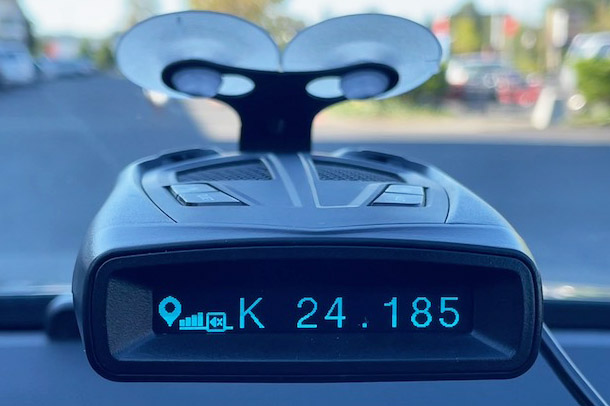
Titan locking out a shopping center door opener
Autolockouts are available too so the Titan can lock signals out for you on your regular commutes. These lockouts are also more finely tuned and less aggressive than manual lockouts. Instead of locking out all of K band, auto lockouts just lock out a small section of K band around the frequency of the radar source. In order for an autolockout to be created, you need to pass by a source and get a full strength alert 3 times over a period of 30 days.
Manual lockouts can be helpful for speed signs that drift in frequency beyond what autolockouts would cover.
Note: Autolockouts are disabled by default. To enable, set an autolockout radius for the “XK RAD” menu option. (The “RAD” menu option is a separate option to control the alert radius that applies to manual lockouts and other GPS POI’s including RLC’s and user points.)
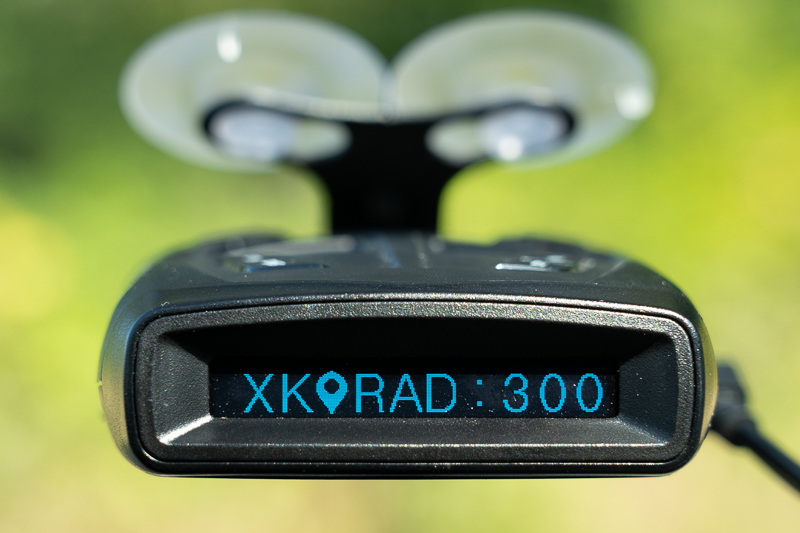
Autolockouts Enabled w/ 300m radius
Auto unlearn is built in too. If the radar sources goes away, like if a temporary speed sign is removed, after 3 passes over 30 days where you no longer see the signal, the detector will delete that lockout.
One nice touch I like is when you enter a GPS lockout zone, you’ll see a little “pin” icon on screen (instead of the satellite icon) letting you know that you’re in a lockout zone.
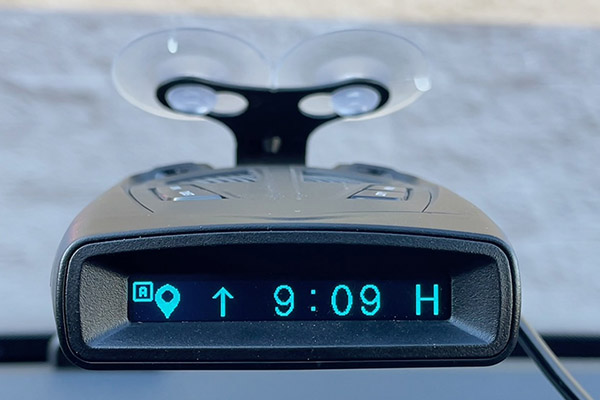
Titan displaying a GPS lockout zone pin
The Titan can store 300 manual lockouts and 300 autolockouts. It also has extra memory to keep track of all the X and K band signals seen over the past 30 days.
This is less lockout memory available than with other detectors. To save memory, if you’re in a parking lot and low speed muting is quieting the detector, you can’t lock the signal out. Instead you’ll rely on other filters and fall back to lockouts as needed just for any stronger alerts at higher speeds.
In my testing I’ve only used manual lockouts (because I’m impatient and know all the false alerts in my area, haha). I just recently learned about manual lockouts covering all of K band so I’m going to revert to relying on autolockouts moving forward. Either way it’s awesome to finally have a Whistler detector that supports both manual and automatic GPS lockouts. It’s a must-have feature when driving in the city, IMHO.
Speed-based Controls
The Titan has a number of ways to automatically adjust the detector’s behavior based on speed.
Want to keep all X and K band alerts fully muted when traveling at low speed? Set your low speed quiet threshold with the “LSQ XK” option.
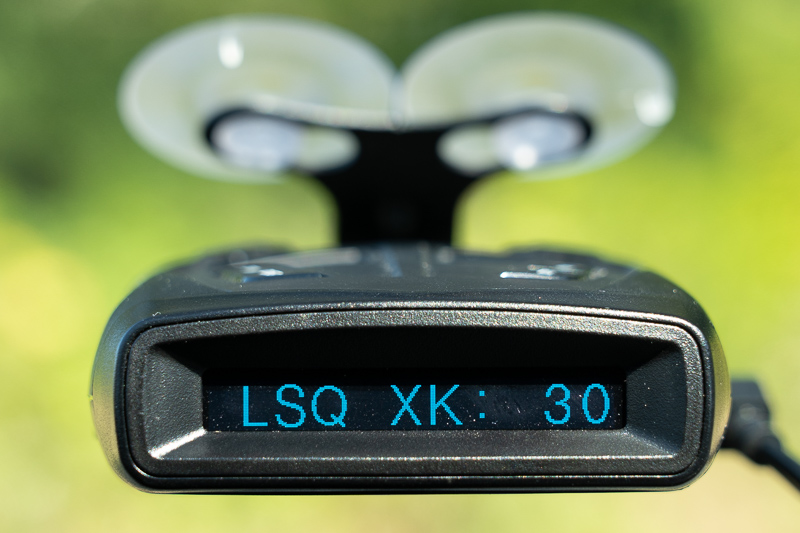
Low speed muting for X & K band < 30 MPH
Want to keep the detector quieter around town, regardless of band? Set “AQ Speed” to the speed threshold you want and then set “AQ Vol” to a volume level between 0-3. Then all alerts will play back at that volume level when traveling below that speed.
Does your car have a lot of road noise and wind noise on the highway? Enable “SPDVOL” to have the Speed Volume option progressively crank up the detector’s volume the faster you go.
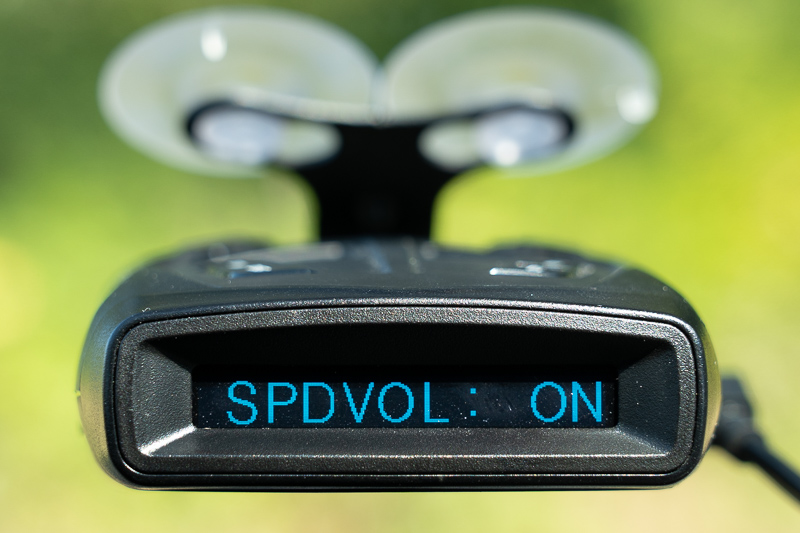
Alert volume varies based on speed
Want to have your detector mute just weak alerts at low speed, but still alert you to strong alerts? Set your Titan to City mode and then set the Speed Selectable City Mode (C-SPD) to a chosen speed and now when you’re traveling at lower speeds, weak alerts will give you just two beeps instead of the normal full alert. As the signal gets progressively stronger, you’ll get two additional beeps. Drive faster than the C-SPD threshold and the detector will revert to Highway mode where both weak and strong signals alert normally.
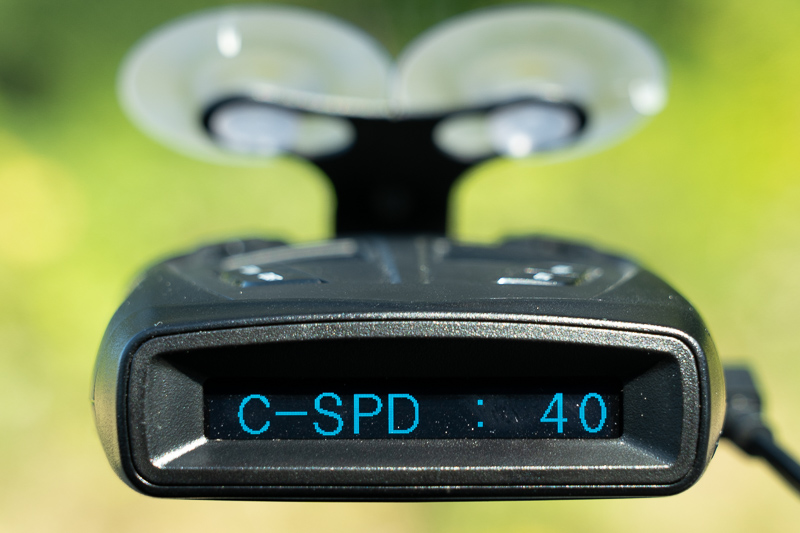
Switch between Highway and City modes at 40 MPH
So there’s a ton of speed-based configurability available with the detector. I found it confusing at first, but then pretty cool once I learned how to use it.
The main speed-based option I find myself missing is the ability to vary the detector’s sensitivity by speed. You can adjust the sensitivity of X, K, and Ka band between Low, Medium, and High, but this is a fixed option, not something that can vary based on speed.
MultaRadar Detection
The Titan also offers detection options for both the MRCD and MRCT photo radar systems, another first for Whistler.
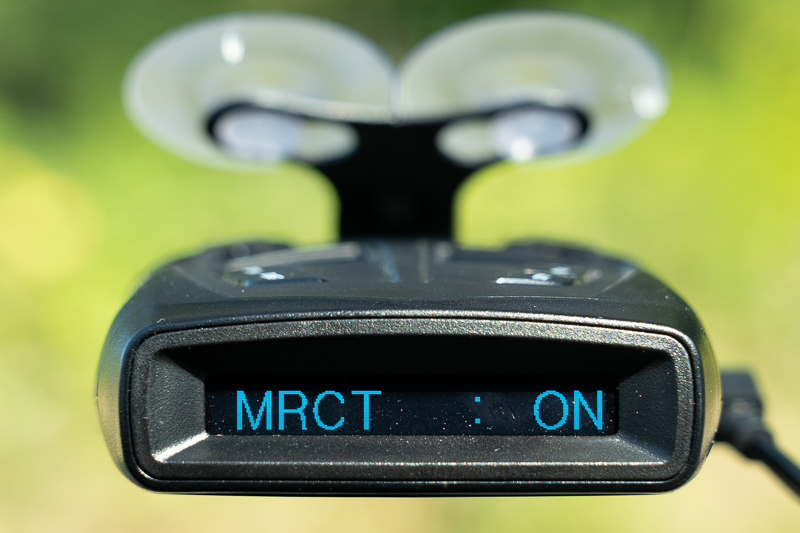
I don’t have these systems in my area so I can’t test them out myself. It seems to do a pretty good job with MultaRadar falses, but in my experience I’ve found it does false to MRCD and MRCT when encountering some shopping center door openers. I’ve also seen occasional MRCD falses from certain BSM’s. To be fair, every MultaRadar-capable detector falses to MRCD/CT sometimes, some more than others.
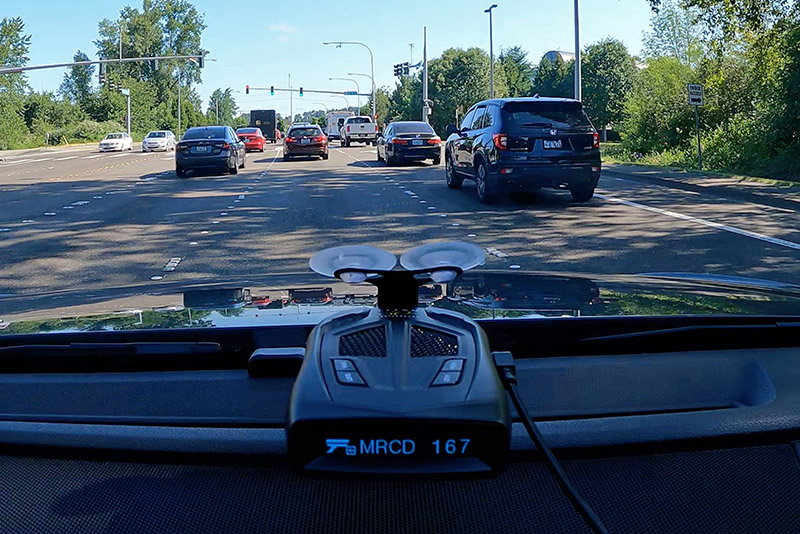
MRCD false to Honda Pilot BSM at 24.167
By default the detector scans K band between 24.050 – 24.250 GHz. You can have MRCD/CT scan the same frequency range, or you can select an Extended option to expand MultaRadar detection down to 23.900.
The algorithm that the Titan uses is pretty simplistic and I haven’t yet seen any realworld testing done to compare its effectiveness, accuracy, and detection range. No one in Canada has had a chance to test it out yet either. Once fellow testers get ahold of these units and report their results, then we’ll find out how effective the Titan is.
Ka Band Segmentation
Ka band segmentation is available on the Titan. However, this is purely for muting purposes, not to improve performance. It always sweeps all of Ka band, regardless of how many or how few of the 10 Ka segmentation options you choose. (They’re designed so that 2/5/8 still correlates to 33.8/34.7/35.5.)
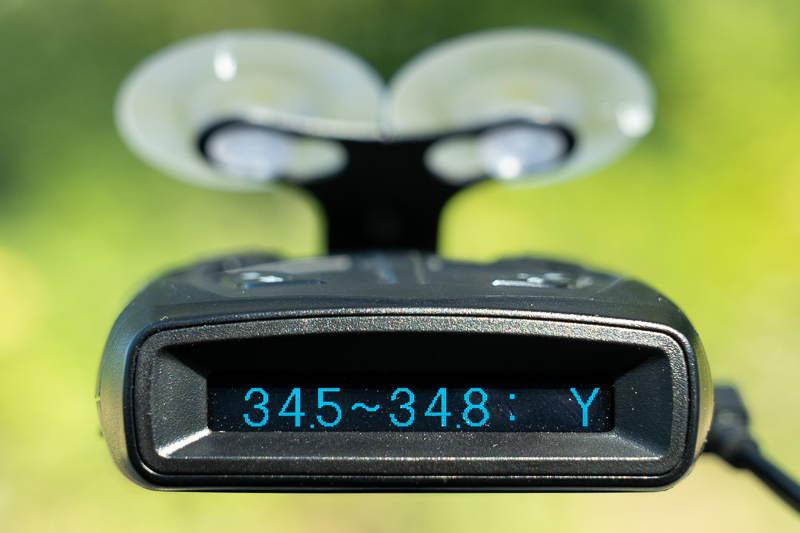
In my time driving with it, Ka falses are well controlled, even with the Ka Filter disabled.
There are no K band segmentation options.
K / Ka Band Confusion Fix
One big annoyance with the CR93 and CR97 was that they would sometimes misreport K band falses as Ka, a big deal since Ka alerts are a much higher priority. K falses are common, but Ka falses are rare. If my detector goes off to Ka, I pay attention!
With the Titan, this issue looks to have finally been resolved. Thank goodness. For this reason, I find the Titan to be much more usable, day to day.
User Profiles
Another new feature are programmable user profiles. You can create up to 3 different settings presets and switch between them on the fly. You can also name each profile (up to 5 characters) to make it easier to remember what each profile is for.
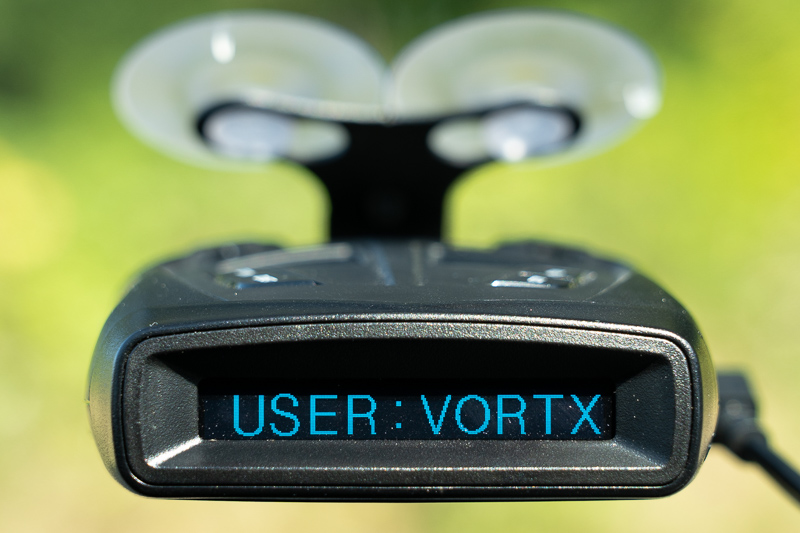
This can be useful if multiple drivers share the same detector, for example, so each person can switch to the settings they prefer. It can also be helpful if you need different settings when driving through different states or if you wanna quickly switch filtering settings during radar detector testing.
Intellicord 2.0
The cig. lighter power cord has been upgraded as well. The detector itself still uses a barrel connector for power, but the power cable has been upgraded to Intellicord 2.0. Here’s what the new cable adds:
- USB port to charge your phone (USB A connector, up to 2.1 A)
- Supports higher current levels for a more powerful detector and USB port
- Remote mute button now supports two different functions with short vs. long press
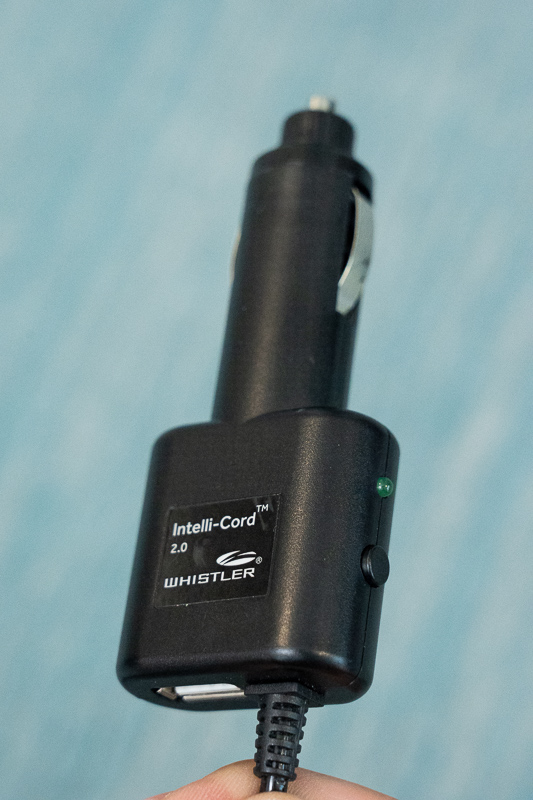
Besides the added USB port, the main practical benefit are the new S1 / S2 features with the remote mute button on the side of the plug next to the green alert LED.
You can program the detector to do different things based on a short press or a long press including:
- Quiet: Mute / lockout signals
- Waypt: Create a GPS user mark alert
- User: Switch user profiles
- City: Change sensitivity modes
- Dim: Adjust display brightness
- Power: Turn the detector on or off
I like setting S1 (short press) to “Quiet” to conveniently mute falses or lock out speed signs.
Pro tip: If you use S2 (long press) to switch User profiles, ensure that all 3 profiles have S2 set to “User” so you can easily cycle between the different profiles.
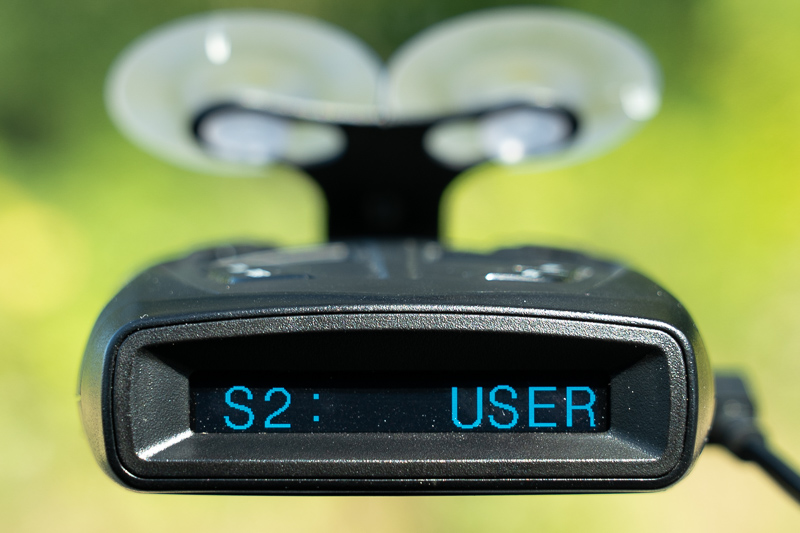
RDD Immunity
When it comes to stealthiness, I found that the Titan is pretty detectable by radar detector detectors. With both the Spectre III and the newer Spectre Elite, I could start picking up the Titan around 1000 – 1200′ away. It effectively maxed out my test course. On a longer course it’s possible that the Spectres could pick them up farther away.
You can see how it fares in my video review starting at 15:13:
It’s easier to pick up the Titan from the front than from the rear, but if an officer pulls up behind you at a red light, they’ll still be able to tell that there is a radar detector directly in front of them.
While this capability isn’t necessary for most of us here in the US, if you drive in an area where you need a truly undetectable detector, I would suggest you skip on the Titan and pick up something else.
Laser
When it comes to laser detection, Whistlers have some pretty cool features and the same is true for the Titan.
First off, when you get shot with laser, the Titan can display the pulse rate of the gun, ie. 200 pps. It doesn’t translate that into a potential gun ID, but rather it displays the pulse rate during the laser alert.
If you pass by an area that regularly falses your detector to laser, you can press the Quiet button to lock out laser alerts with this same pulse rate. Next time you come by, the detector will give you two quick beeps and then go quiet.
Driving around, I’ve encountered occasional laser falses from sources I can’t identify. Maybe it’s from other nearby cars, but I’m not sure.
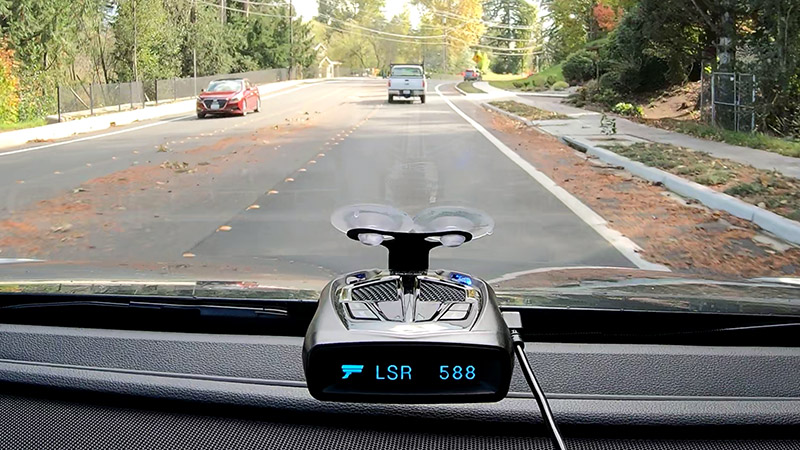
Titan alerting to a 588 pps laser source
Laser segmentation is also available if you’d like to enable/disable alerts for different pulse rate ranges.
- 20 Hz – 950 Hz
- 2600 Hz – 3200 Hz
- 3800 Hz – 4200 Hz
Here in the US we’ll want all 3 segments enabled, but if you drive in a country where officers only use specific lidar guns with certain pulse rates, you can disable the ones you don’t need and cut down on false alerts.
Firmware Updates
Firmware updates are pretty straightforward. You can download both the update software and the individual update files from Whistler’s downloads page.
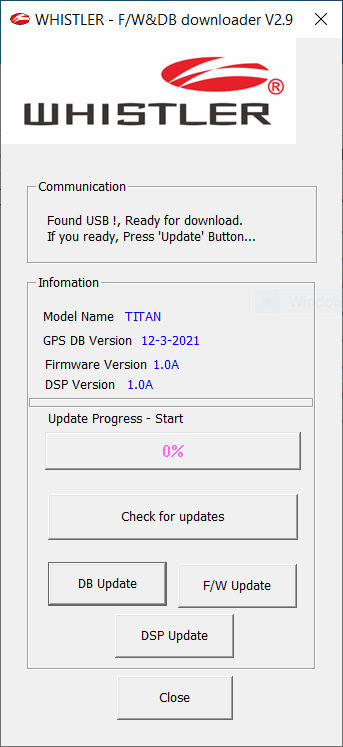
You’ll want to install and run the update software, plug your in Titan via the MicroUSB port, and you can click the “Check for updates” button which’ll take you to Whistler’s website where you can find the latest updates for the GPS database, the detector’s firmware, and the DSP. Download the individual files to your computer, load them into the software, and then copy them over to your detector to update.
The software is Windows only. There’s no Mac support unfortunately, so any fellow Mac users will need to find a Windows computer to update or run windows on their Mac.
Cool Random Features
Finally there’s a few other random cool features I’d like to mention that don’t necessarily warrant an entire section.
When you’re in the settings menu, you can scroll both forwards and backwards. If you scroll past a menu option by accident, you can go back instead of having to cycle all the way through the whole menu again.
The settings menu also stays open for a super long time and doesn’t time out as fast as other detectors. If you want to exit the menu, just hit the power button on the side. Also next time you go back into the menu, it brings you right back where you left off rather than starting over at the beginning again. Very convenient.
If you manually mute a BSM false, you’ll see a small “muted” icon in the lower left corner of the display, even after the signal goes away. If the signal comes back, the detector will remute it. You can visually confirm how long that mute latch lasts by seeing when that mute icon finally disappears.
The Titan can announce Ka frequencies if you enable “RSID-V.” If you get a 34.693 alert, for example, it will announce “34.7” as part of the normal Ka alert.
Additionally if you get hit by a strong instant on shot, the detector will display “Pulse” on screen before switching over to the standard traditional display.
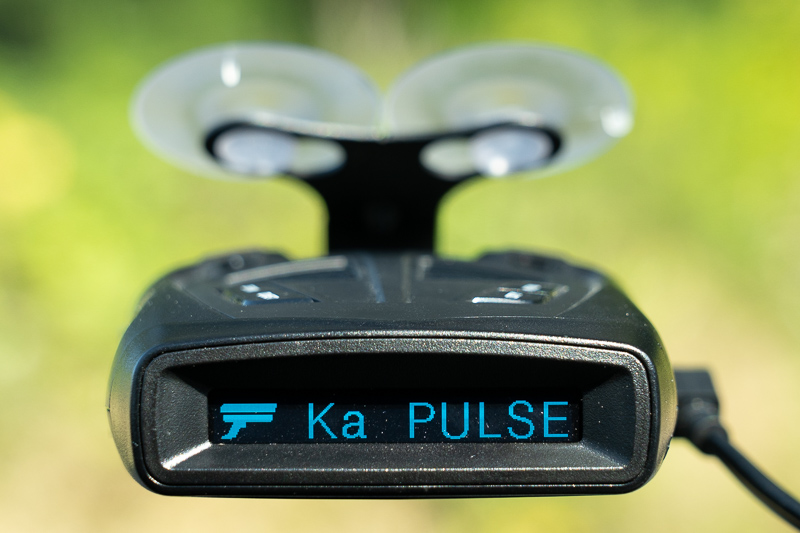
MultaRadar alerts can be locked out like normal K band alerts.
You can set the GPS to “Stealth” mode which turns off the detector’s display after you’ve been parked for a minute. This is helpful if your vehicle’s cig. lighter is always hot, even when the car is off, and you don’t want the detector to be so visible in a parking lot. You can also set the “Battery Saver” option to fully power off the detector after 1, 2, or 3 hours.
You can also individually control the detector’s sensitivity to X/K/Ka bands. It’s not a dramatic difference, only a dB or two each, but if you’d like to adjust it, go to the setting where you turn the bands on or off and hit the Vol + or – buttons to adjust the sensitivity.
Features I Would Like
What features would I like to see added to the Titan?
RLC high speed muting. Sometimes when driving on the highway, the Titan alerts to red light cameras on nearby surface streets. I can cut down on some of these by reducing the alert radius, but some are literally on an intersection right under the highway overpass and so I’d love to have the option to mute RLC’s when I’m traveling at highway speeds.
GPS lockout changes and more lockout memory. For manual lockouts, I prefer having it only lock out a small section of K band. I can appreciate having a single lockout nuke all K band signals which can be useful for parking lots with tons of door openers that would require multiple lockouts, but personally I’d rather see a detector with more memory built in and then give me more selective lockouts. However with low speed muting taking care of parking lot falses and auto lockouts taking care of speed signs, I can work around it for the most part.
K Notches. Being able to selectively mute weak K band alerts around the typical BSM false alert frequencies would be helpful to further quiet down the Titan.
Reduce K band sensitivity based on speed. I’d love to see some speed-based sensitivity control available on the Titan like we have with other detectors. It has a bunch of speed-based muting controls and this helps keep the detector quiet overall, but being able to dial back the K band sensitivity a bit when it’s not needed can sometimes be helpful.
Mac update software and automatic firmware checks. As a Mac user, it’d be great to have native Mac software and not need a Windows computer or to run Windows on my Mac. For the sake of simplicity, instead of having to go to Whistler’s site to manually download the individual update files, it’d be nice if the software could grab the update files for me if an update is available and then go ahead and update my detector accordingly.
Multicolor OLED. The blue OLED display is fine in practice, but it is nice having a multicolor OLED so you can have different colors indicate different things.
Skip displaying settings on startup. At startup the detector will cycle through some of the key settings and display them on screen. You can have the detector boot up silently if you like, but you can’t have an instant startup. This settings display only adds an extra 7 seconds to the bootup process and it can be nice to see which profile is currently running, but once I get everything dialed in, I like the detector to be up and running ASAP.
Optional Ka lockouts. If you have a satellite dish that triggers Ka falses in your area or a Ka band speed sign (rare, but there are some), it’d be nice to have the option to lock out those rare Ka falses. Ideally I’d like the manual Ka lockout to affect just a small section of Ka band too, not the entire band or segment.
Whistler is generally pretty good about listening to user feedback. The software in the detector isn’t written in stone and so if there’s any features or changes that lots of people want, they’re open to improving the detector accordingly.
Compared to Competition
How does the Titan compare to the competition? At $349, here’s how it compares to its closest competitors.
Uniden R3 vs. Whistler Titan
The Uniden R3 ($299) is a very popular choice and it’s one of the go-to recommendations in this price range.
The Whistler Titan ($349) is $50 more and for the money you get automatic GPS lockouts, a 3 year warranty (instead of just 1 year), plus the custom user profiles. In my mind the autolockouts would be the biggest reason to choose the Titan over the R3.
Radenso XP vs. Whistler Titan
The Radenso XP ($349) is the same price as the Whistler, but the Titan gives you longer range, autolockouts, and photo radar detection. The Radenso offers a ticket-free guarantee, but I’d rather invest in the better performing and more fully featured detector. In my mind the Titan is the winner.
Escort Max 3 vs. Whistler Titan
The Escort Max 3 ($399) is $50 more than the Whistler. The main reason to choose it over the Titan would be for the added Bluetooth functionality. This makes it easier to change settings on your phone, it can display the current speed limit of the road you’re on right on the detector’s display, and it lets you share alerts in realtime with other drivers via Escort Live (though Waze works better and can be run alongside any detector). Escort also offers a ticket-free guarantee too, but I think that Bluetooth is its biggest advantage.
Conclusion
The Whistler Titan is the best radar detector Whistler has ever made. It offers long range performance, effective false alert filtering, manual and automatic GPS lockouts, photo radar detection, and even custom user profiles. It addresses the biggest issues I had with the previous generation flagships and so now for the very first time, I would be comfortable recommending a Whistler and even including it in a list of “best radar detectors.” If you’re looking for a detector around the $350 price point, the Whistler Titan should definitely be on your short list.
You can order the Whistler Titan here.
| This website contains affiliate links and I sometimes make commissions on purchases. All opinions are my own. I don’t do paid or sponsored reviews. Click here to read my affiliate disclosure. |

